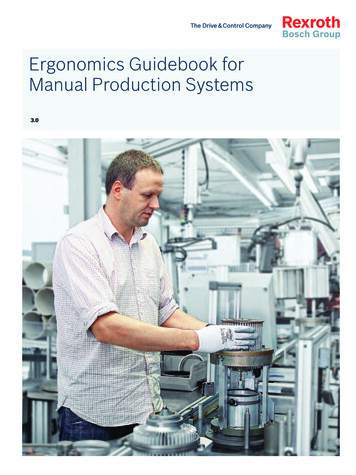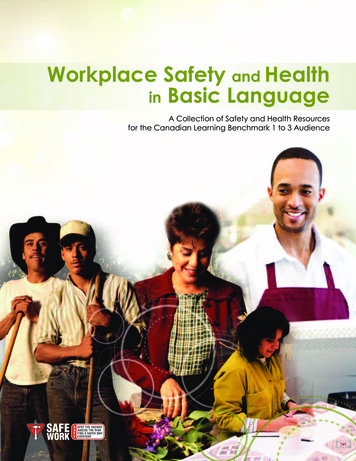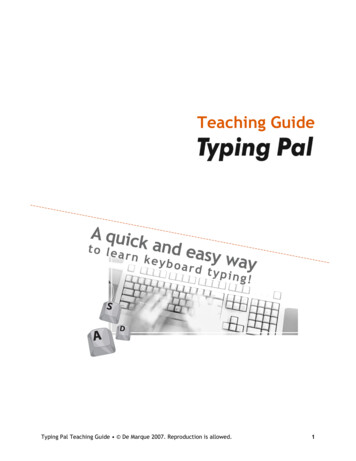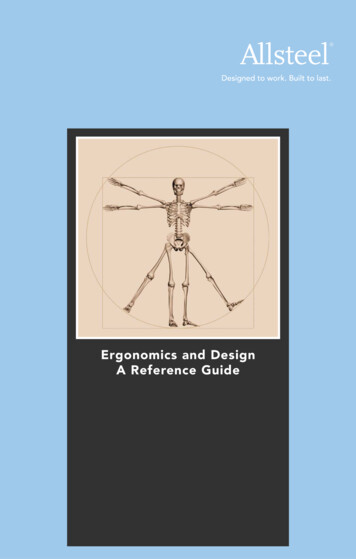
Transcription
Ergonomics Guidebook forManual Production Systems3.0
2The eight rules of ergonomicsfor work systemsBody height 04Work area 06Reach zone 08Parts presentation 09Range of vision 10Lighting 11Equipment adjustments 12Planning aids 14Benefit from ergonomicsUse the advantages of an ergonomically designed workstation system.We can support you with this and provide valuable suggestions. One exampleis this ergonomics guidebook, which contains the eight key rules of ergonomics,covering the most essential aspects of EN ISO 6385.This guidebook is a reference to help you methodically plan and implement ergonomicworkstations and flow racks. Among other things, it takes employee size, tasks, andlighting into account.
Ergonomics – For motivated employees, higher productivity, and better qualityAn ergonomic workstation facilitates work and maintains good employee health.The results: Increased motivation and satisfaction, higher performance, efficiency,and processing quality, as well as fewer absences due to illness. The bottom line:Ergonomics provide you with valuable benefits in the form of higher productivity,increased efficiency, and a decisive edge over the competition – thus ensuringlasting success for your company.0406080910111214Body height and working heightWork areaReach zoneParts presentationRange of visionLightingAdjustment of work equipmentPlanning and design tools3
4Body height and working heightManual workstations must accommodate a wide range ofDefinition of the optimum working heightbody heights to ensure that the largest percentage of theThe optimum working height is based on the body heightpopulation is covered. Country-specific differences andrange and the type of activity to be performed (see table).regional requirements must also be taken into account. ForIf you take all body heights into consideration, the averageexample, in Germany, DIN 33 406 must be followed whenoptimum working height for average requirements isspecifying and designing a workstation. The most important1125 mm for sit-down/stand-up workstations.factors for designing work equipment are the workingheight, proper sizing of the reach zones and required legroom, as well as definition of the appropriate range ofWork contentsGroup 1Group 2Group 3Group 4High requirements forVisual inspectionFine motor skills1100120012501350Medium requirements forVisual inspectionFine motor skills1000110011501250Low requirements forVisual inspectionHigh requirements forElbow-room900100010501150vision. All of these dimensions are derived from a“standardized” body height.Classification of body heightsThe body heights of the population can be classified intofour groups:ff Group 1: Smallest woman (only 5% are smaller)ff Group 2: Average woman and smallest manff Group 3: Largest woman and average manff Group 4: Largest man (only 5% are larger)Working heights in mmAverage optimum working height 1125Grouping of body heights in Germany:In accordance with DIN 33 402 and DIN EN ISO 7250Average optimum working height:For all four population groupsFrequency1%1125 mm 100 mm5%50%95%99%Men:1650 mm1750 mm1855 mmWomen:1535 mm1625 mm1720 mmGroup 2Group 3Group 4Group 1Group 11535 mmGroup 21640 mmGroup 31740 mmGroup 41855 mm
Definition of the table heightThe table height follows from the optimum working heightminus the height of the workpiece or insertion point. ToRelevant parameters:For defining the table heightfor a sit-down/stand-up workstationensure sufficient leg room for those in body height group 4as well, we recommend a minimum height of 1000 mm forsit-down and stand-up workstations. Further criteria thatmust be taken into account:ff Foot and leg room, depth and adjustment range ofthe footrestff Size and variation of workpiece dimensionsff Occurring forces and weightsff Local specifications (deviating body heights, legalrequirements, etc.)ff Aspects related to methods, safety, and efficiencyTable heightff Greatly varying vision distancesWorking height Hff Changing types of equipment and insert heightsRexroth's sit-down/stand-up concept for productionThe sit-down/stand-up concept developed andrecommended by Rexroth makes it possible to work atthe same height when sitting and standing. This largelycompensates for different body heights. The conceptpermits changes in posture, which reduces stress andRecommended working heights:A: Higher container weight, B: Lower container weightC: Occasional handlingincreases performance. This is not possible with a purelysit-down or stand-up workstation alone.CFlow rack designThe container weight and type of activity are decisivewhen designing flow rack systems. We recommend the1400 mmB1100 mmarrangement shown in the figure. The following aspectsAshould also be taken into account for material supply andremoval:600–750 mmff Total load on the employee during the shiftff Country-specific requirements and standardsB400 mmC5
6Work areaThe required activities and work process are definedff Promote dynamic activities:based on a specified cycle time. The optimum workingStatic holding activity inhibits the blood circulation andmethod is determined in a method analysis that takes time,supply of oxygen to the muscles. This can lead to a dropergonomics, and efficiency into account. It’s also importantin performance and processing quality.to consider any trends towards an aging work force orchanging employee performance. According to ourff Allow for varying physical exertion:experience, inclusion of all concerned employees, forFor example, through sit-down/stand-up workstations orexample from assembly, quality assurance, and logistics,job rotation. Varying physical exertion reduces stress onensures the best results and long-term acceptance of thethe employee and increases performance.method and, as a result, acceptance of the workstationsystem. The work area height should always be betweenff Minimize exertion:800 mm and 1500 mm. Here, the following rules must beFor example, through the use of manual roller sectionsobserved:or lifting aids, as well by selecting lighter weightmaterials.ff Avoid work above the heart (over 1500 mm):Otherwise, the blood circulation and supply of oxygento the muscles is reduced, which leads to a drop inperformance. Work that requires bending (below800 mm) taxes employees disproportionately and shouldbe avoided.Above the heartWork areas above the heart: Decreased blood circulationreduces performanceBelow the heartWork areas below the heart: A good supply of oxygento the muscles and increased performance
Ergonomic workstations are at the center of assembly lineproductionSit-down/stand-up workstations as well as material supplycontainers from Rexroth provide an optimum basis for workwithout fatigue and can be adjusted to the needs of individualemployees.At restBlood requirementStatic activityStatic activities, such as holding an objectcontinuously, reduce the blood and oxygensupplyBlood supplyBlood requirementBlood supplyDynamic activityA sufficient oxygen supply is ensured withdynamic activitiesBlood requirementBlood supply7
8Reach zoneThe following rules apply for an ergonomic reach zonedesign: All containers, equipment, and operating elementsmust be easily accessible and arranged in the anatomic/Reach zone for the smallest woman(body height group 1)physiological range of movement for the employee. Torsorotations and shoulder movements, particularly when under400exertion (with weights 1 kg), should be avoided wheneverApossible.200BCharacterization of the three reach zonesCArea A0ff Optimum for working with both hands, as both handscan reach this zone and are in the employee's field ofviewff For fine motor movements0300700All dimensions in mmff Possible to handle lighter weights and also enablesimproved inspection and coordination activitiesff Pure lower arm movementsff Smaller muscle groups are in useff Area for workpiece support, workpiece pallet, orYou can differentiate between three reach zones at the workstation:ff Area A: Center of work, two-handed zoneff Area B: Large reach zoneff Area C: Extended one-hand zoneequipmentArea Bff For gross motor movementsff Area for tools and parts that are often grabbed with onehandff Upper and lower arm movements without use of theshoulders and rotation of the torsoArea Cff For occasional handling, e.g. of empty containers ortransferring parts to the range of movement for the nextemployeeff With shoulder and torso movementSit-down/stand-up workstation:Parts transfer via Eco-Flow roller sections
Parts presentationAll reach distances should be as short as possible to avoidunnecessary movements that add nothing to the value andthus avoid waste. Grab containers and parts containersthat are in direct reach of the employee are ideal. Theposition of these containers should enable a flowingmovement that curves upward away from the body whenparts are removed.The following aspects must be taken into consideration forparts supply:ff Positioning of all grab containers in areas A and Bff The more frequently a grab container is used, theshorter the reach distance should beff Heavy parts should be stored within reach in the lowercontainers to avoid unnecessary exertion (e.g. caused bylifting and lowering)ff Bending of the torso below 800 mm places adisproportionate strain on the human bodyff Use of geometric and physical features of the partsduring parts transfer, e.g. through the use of a slide railor roller conveyorff Arrangement of different-sized containers according toparts geometry, maximum weight, and refill cycleff Reduction of time for parts supply and removal by up to68% (MTM – Method of Time Measurement). Employeescan concentrate on productive assembly workcc Let our case lifters help you to keep sick days downff Exchangeable material supply shuttles reduce setup times9
10Range of visionFor optimal workstation design, it’s important to followrecommendations on proper ergonomics for vision as well.Range of vision from above:The field of view is red and the visual field is light gray.You can differentiate between two vision areas:ff In the field of view (red vision area), several objects canbe seen in focus simultaneously without moving the eyesor head. Additional focusing for depth may be requiredhere.ff In the visual field (light gray vision area), objects can beseen by moving the eyes, but not the head. Additionalfocusing for depth may also be necessary here.Head movements are required outside these ranges. Whenstanding, the angle of view is 30 from the horizontal planeand 45 when sitting.Definition of the assembly station and parts supplyThe following aspects must be taken into account duringplanning:ff Avoid unnecessary eye and head movementsff Implementing vision distances that are as identical aspossible eliminates refocusingRange of vision from the side:The field of view is red and the visual field is light gray.ff Avoid fastening locations not visible to the workerComplying with these three recommendations facilitateswork and increases productivity. Every time you turn your45 head or change the direction of vision and refocus resultsin lost time and money. The exact values can be determinedvia the MTM procedure.60 30
11LightingThe right light, adapted to the activity at the workstation, isa basic prerequisite for high efficiency and processingquality. Optimum lighting prevents premature fatigue,improves concentration, and reduces the risk of errors.Important aspects for planning workstation lighting include:ff Avoid strong contrastsff Avoid glare and reflectionff DIN EN 12 464 and the table below contain the requiredmid-range lighting intensitiesLighting of test workstations that is free of shadows,flickering, and glare (see figure)The right Rexroth system light for every taskCalculation example for work top lightingRexroth SL 78 (nominal luminance intensity) 681 lux(lamp-to-table distance 1.25 m) ambient lighting 300 lux work top luminance intensity of 800 luxTasksRequired luminance Rexrothintensity (lux)SL 36 DuoRexrothSL 72 /economicRexrothSL 78Rexroth SL 78 SL 36 DuoRough and average machine and assembly tasks such asturning, milling, and planing3001)1)Fine machine tasks with permissible deviations5001)1)1)Fine assembly tasks, e.g. telephones, winding mediumsized coils, marking, inspection, and measuring stations7501)1)1)1)Very fine assembly, e.g. measuring instruments, assemblyof tools, gauges, and equipment, precision mechanics andmicromechanics10001)1)Assembly, inspection, and adjustment of extremely smallparts15001)Distance between the table top and light: 1.25 mLamp luminance intensity sufficient for taskLamp luminance intensity ambient light (300 lux) sufficient for task1)
12Adjustment of work equipmentTo maintain performance and promote productivity, allwork equipment near the workstation must be preciselyAdjustment of the workstation to the employeeadjusted to the employee and the activity.All of the Rexroth components for equipping workstationscan be combined to form a perfectly coordinatedergonomic system. Rexroth products offer numerousadjustment options that promote proper posture andreduce fatigue. We make ergonomics simple and youbenefit.High performance and productivity require the right sittingposture: The worker’s calves and thighs should form a 90 angle. This also applies to the upper and lower arms,though here the angle may be slightly greater than 90 . Thelumbar support should permit individual adjustments to thebody height and optimum support point of each user.Correct adjustment of the table, chair, footrest, and grabcontainers, as well as the position of tools and materialshuttles, minimizes movements, thus reducing physicalexertion and employee absences. Rexroth swivel workchairs feature an ergonomic seat and backrest design. TheAdjustment of material shuttles to the employeeAdjust as needed:1 height, 2 depth, 3 anglepermanent contact backrest also adapts itself to the upperbody movements of the user, thus supporting the back inevery position.231
13A few important considerationsff When adjusting the chair and footrest, make sure thatthe thighs and calves form a right angleff Information boards should be hung at eye level to avoidunnecessary head movementsff The angle of the shelves for material supply should beadjusted to create short, direct reach distancesff Use lifting aids to supply heavy partsff Monitor brackets and tool shelves can be adjusted toany height via the profile slotff With height-adjustable workstations, the optimumworking height can be adjusted according to the size ofthe person or product Information on how to adjust thework equipment can be provided on information boardsIf processes, products, or employees change frequently,check the work equipment regularly to ensure properergonomic adjustment.Separate adjustment of material feed height andworking height:Height-adjustable workstations can be adapted to boththe product and the worker.
14Planning and design toolsPlanning templates help you to easily generate sketches or checkwhether CAD printouts are ergonomic. You can also take advantageof MTpro, our planning software for assembly systems. Rexrothguides you through all the necessary steps to select, configure, andorder products.Ergonomics templatesFor the average woman or smallest man (group 2).Scale 1:10. The two figures are not shown in original size!3 842 542 2863 842 542 287
15Savings in timeQuerywithout MTprowith MTproDrawingParts listee MTpro offers:–– Savings in time–– Flexibility–– Error prevention–– Clarity–– StandardizationQuoteOrderDeliveryTimeee Multiple workstationsare linked to form aproduction line thatfollows lean productionprinciplesThis highly user-friendly software accelerates and simplifiesplanning of application-specific workstations, flow racks,and material shuttles. Complete orders can be placed in notime at all. The data can also be easily imported into yourCAD or VR (virtual reality) environment via a CAD interface.
Bosch Rexroth AGPostfach 30 02 07D-70442 Stuttgart, GermanyTel.: 49 711 811-30698Fax: 49 711 811-30364www.boschrexroth.comYou can find local contact information at:www.boschrexroth.com/addresses3 842 525 794 (2012-01) EN - DC-IA/MKT Bosch Rexroth AG 2012. Subject to changes! Printed in Germany.
2 Body height 04 Work area 06 Reach zone 08 Parts presentation 09 Range of vision 10 Lighting 11 Equipment adjustments 12 Planning aids 14 The eight rules of ergonomics for work systems Benefit from ergonomics Use the advantages of an ergonomically designed workstation system.










